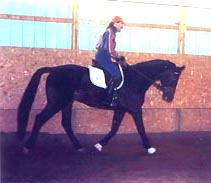|
The rider's aids (the seat, legs
and hands, as FEI judge Hubert Rohrer would phrase it) are what creates the communication between equine and human. The legs
are in contact with the horse's barrel, the seat balances the rider's torso and provides a base for the limbs to function
from, and the rider's hands (whole arm) are in contact with the horse's mouth through an extension of the rein. As Bill Woods
stated at the 1988 Equine Symposium, "dressage is a relationship of nonverbal language and the essence of dressage is how
this communication between horse and rider is enacted."
The horse is 'on the aids' when
it strides forward from the rider's driving or directing leg through the rider's torso (seat) and into the rein, which captures
the horse's present state of impulsion. Then the rider's hands aid, or signal, this captured energy back into the horse's
movement via a half-halt. Throughout dressage riding there is this constant communication between the rider's aids and the
horse's muscular body. Woods calls this a 'feedback loop', which works second by second and stride by stride. In order to
attain the above feedback loop the proper basic position is required. (A dressage rider's body should be relaxed, aligned
and symmetrical.) Then a rider's aids must learn to coordinate not only to ride the horse but also to be used in a way as
to not interfere with the horse. A stiff or unbalanced rider will restrict the horse's movement.

|
| Kristin and a Holsteiner gelding which came to her for training. |
|
 |
|
|
|
 |
 |
 |
|
A rider, once basic position is
acquired, then needs to learn how to coordinate his/her aids without not only interfering with the horse's movement, but without
interrupting his/her own body as well. For instance, the rider must be able to coordinate an outside leg aid without the torso
shifting weight, or be able to use a rein aid and not lean in either direction with the upper body. All limbs are required
to work independent of the others.
Reading literature about how to
ride dressage helps a rider to intellectualize about the use of his/her aids. For example, a knowledge that aids can be broken
down into two categories, parallel and diagonal aids, provides the rider with an abstract knowledge of what should be happening.
But, as all riders eventually learn, and most trainers teach, is that riding is a process of concrete feeling, and not a concept
of abstract knowledge.
Therefore, acquiring this feeling
of applying aids in order to communicate with the horse is accomplished by riding, riding and more riding. Also, riding as
many different horses as possible will enhance one's ability because each horse's need for a leg aid and/or a half halt varies.
Thus the rider learns not only to feel and be receptive to the individual horse through his aids, but learns to apply the
aids in a positive yet influential manner. "Riding (dressage in particular) is dynamic", states Charles deKunffy in his book
Dressage Questions Answered, and once one begins to tread down its path, there is no doubt that one's personal dynamics
of communicating with the aids to the equine will soon perpetuate through a pulse of two rhythmic bodies harmonizing as one.
|
 |
|
|
|



